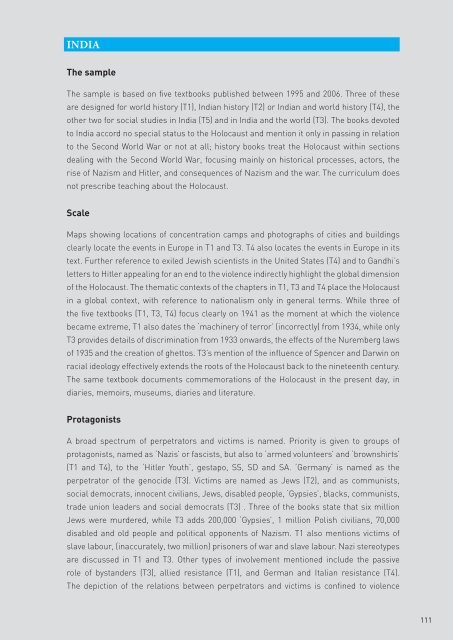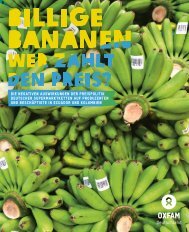228776e
228776e
228776e
You also want an ePaper? Increase the reach of your titles
YUMPU automatically turns print PDFs into web optimized ePapers that Google loves.
INDIA<br />
The sample<br />
The sample is based on five textbooks published between 1995 and 2006. Three of these<br />
are designed for world history (T1), Indian history (T2) or Indian and world history (T4), the<br />
other two for social studies in India (T5) and in India and the world (T3). The books devoted<br />
to India accord no special status to the Holocaust and mention it only in passing in relation<br />
to the Second World War or not at all; history books treat the Holocaust within sections<br />
dealing with the Second World War, focusing mainly on historical processes, actors, the<br />
rise of Nazism and Hitler, and consequences of Nazism and the war. The curriculum does<br />
not prescribe teaching about the Holocaust.<br />
Scale<br />
Maps showing locations of concentration camps and photographs of cities and buildings<br />
clearly locate the events in Europe in T1 and T3. T4 also locates the events in Europe in its<br />
text. Further reference to exiled Jewish scientists in the United States (T4) and to Gandhi’s<br />
letters to Hitler appealing for an end to the violence indirectly highlight the global dimension<br />
of the Holocaust. The thematic contexts of the chapters in T1, T3 and T4 place the Holocaust<br />
in a global context, with reference to nationalism only in general terms. While three of<br />
the five textbooks (T1, T3, T4) focus clearly on 1941 as the moment at which the violence<br />
became extreme, T1 also dates the ‘machinery of terror’ (incorrectly) from 1934, while only<br />
T3 provides details of discrimination from 1933 onwards, the effects of the Nuremberg laws<br />
of 1935 and the creation of ghettos. T3’s mention of the influence of Spencer and Darwin on<br />
racial ideology effectively extends the roots of the Holocaust back to the nineteenth century.<br />
The same textbook documents commemorations of the Holocaust in the present day, in<br />
diaries, memoirs, museums, diaries and literature.<br />
Protagonists<br />
A broad spectrum of perpetrators and victims is named. Priority is given to groups of<br />
protagonists, named as ‘Nazis’ or fascists, but also to ‘armed volunteers’ and ‘brownshirts’<br />
(T1 and T4), to the ‘Hitler Youth’, gestapo, SS, SD and SA. ‘Germany’ is named as the<br />
perpetrator of the genocide (T3). Victims are named as Jews (T2), and as communists,<br />
social democrats, innocent civilians, Jews, disabled people, ‘Gypsies’, blacks, communists,<br />
trade union leaders and social democrats (T3) . Three of the books state that six million<br />
Jews were murdered, while T3 adds 200,000 ‘Gypsies’, 1 million Polish civilians, 70,000<br />
disabled and old people and political opponents of Nazism. T1 also mentions victims of<br />
slave labour, (inaccurately, two million) prisoners of war and slave labour. Nazi stereotypes<br />
are discussed in T1 and T3. Other types of involvement mentioned include the passive<br />
role of bystanders (T3), allied resistance (T1), and German and Italian resistance (T4).<br />
The depiction of the relations between perpetrators and victims is confined to violence<br />
111




